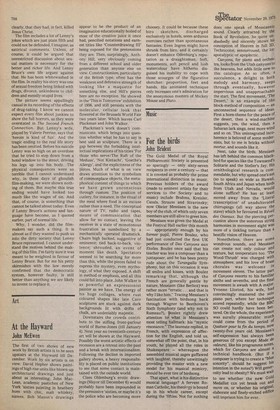Art
At the Hayward
John McEwen
The first of two shows of new work by British artists is to be seen upstairs at the Hayward till December. Work by six artists is on view. David Hepher shows paintings of high rise units like blown-up architectural drawings and just about as interesting; John MacLean, academic pastiches of New York 'sixties painting in heathery hues with chic, malt whiskey, names. Bob Mason's drawings appear to be the product of an imagination educationally boiled of most of the creative juice it once had, pencilled notations and earnest titles like 'Counterdrawing III' being exposed for the pretensions they are. Then, surprisingly, Anthony Hill, very obviously coming from a different school and older generation than anyone else on view. Constructionism, particularly of the British type, often has the weakness and defensive strength of looking like a maquette for something else, and Hill's pieces here are no exception. He showed in the 'This is Tomorrow' exhibition of 1956, and still persists with the molecular, cellular look that flowered at the Brussels World Fair two years later. Which leaves Carl Plackman and John Walker.
Plackman's work doesn't communicate, which brings into question whether what he has to say is best said as sculpture. There is a gap between the forbidding intellectual implications of his titles 'For those who serve/The Raft of the Medusa', 'Not Kintachi', 'Goethe's Allergy', and the explicitness of the pieces. Much of what is on view draws attention to the symbolism of commonplace objects, the metaphorical content of things to which we have grown unconscious through custom. The position of cutlery, for instance, in the ritual of the meal where food is an excuse rather than a need. The conceptual nature of TV, radio and tapes, means of communication that allow for no contact, leaving the receiver in a state of monotonous frustration as sumbolised by a mechanically operated drumstick. Chairs high backed, suggestive of eminence; tied back-to-back, violence; shrouded, an event of moment like death. Spectators seemed to be searching for more than this, while the pieces failed to express the mystery, even mythology, of what they exposed. A shift in method or emphasis, and all this could fall into place. John Walker is as powerful an expressionist painter as we have. The energy of his huge collages, where rust coloured shapes like late Caro sculptures are stuck against dark backgrounds lit with drifts of chalk, are undeniably majestic.
Downstairs the crowds contribute to the stifling front-parlour world of I3urne-Jones (till January 4). Next year no twentieth-century art will be shown at the Hayward. Possibly the worst artistic effects of recession are a retreat into the past and a break with internationalism. Following the decline in imported gallery shows, a heavy responsibility is placed on public institutions to see that some contact is maintained with the outside world.
Claes Oldenburg's erotic drawings (Mayor till December 6) would probably have been impounded in the permissive 'sixties, or maybe it's the police who are becoming more choosey. It could be because these biro sketches, discharged exclusively in hotels, seem arduous exercises rather than spontaneous fantasies. Even Ingres might have shrunk from biro, and it certainly doesn't enhance Odenburg's reputation as a draughtsman. Soft, monuments, soft pencil and lush watercolour have hitherto disguised his inability to cope with those scourges of the figurative sketcher: proportion, feet and hands. His animated technique only increases one's admiration for the anonymous masters of Mickey Mouse and Pluto.


































 Previous page
Previous page